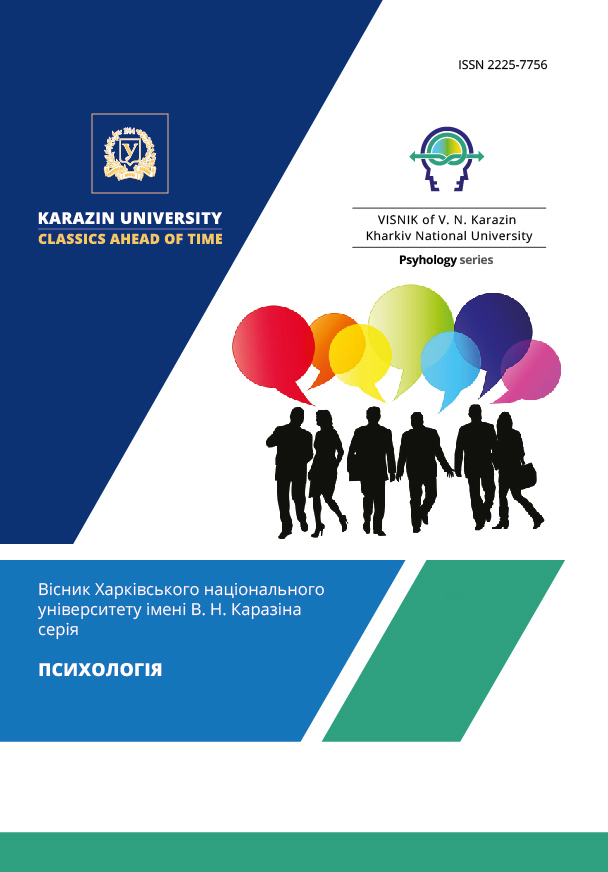Mental states dynamics in civilians during the war in Ukraine
Abstract
The article presents the results of the mental states dynamics study in the Eastern region civilians of Ukraine during the Russian military aggression on the territory of Ukraine in the first year of the war. The paper substantiates the relevance of the study of the mental states of the civilian population in the context of maintaining mental health problem and preventing post-traumatic stress disorders. War is a prolonged traumatic situation during which episodes of a threat to life and health occur with a certain frequency, and this affects the dynamics of the mental states of the civilian population. An additional traumatic effect on the psyche is exerted by the information and psychological warfare that people are exposed to through Internet technologies. The study found that at the beginning of hostilities in Ukraine, the most typical mental states of civilians in the eastern regions of Ukraine were fear, confusion, helplessness, despondency, depression, panic, irritability and anger. These mental states are typical of the acute experience of a traumatic stressful situation. A year after the start of the war, respondents noted a significant decrease in the frequency of experiencing fear, confusion and panic. At the same time, sadness, depression, fatigue, exhaustion, anxiety, and irritability became common. These are mental states that testify to the reduced energy potential of the population, the danger of new fears and outbursts of irritation. The consequence of this may be a violation of interpersonal relationships, professional maladjustment, the development of psychosomatic and post-traumatic disorders. At the same time, a number of respondents showed an interest in life, "protective indifference", peace. The results of the study can be used in the development of psychotechnologies to minimize the consequences of war-related injuries, as well as to preserve and support the mental health of the population in war conditions and in the long term.
Downloads
References
Boehnlein, J.K., Kinzie, J.D., Sekiya, U., et al. (2004). A ten-year treatment outcome study of traumatized Cambodian refugees. J Nerv Ment Dis, 192:658–663. https://doi.org/10.1097/01.nmd.0000142033.79043.9d
Cardozo, B.L., Bilukha, O.O., Gotway Crawford, C.A., et al. (2004). Mental health, social functioning, and disability in postwar Afghanistan. JAMA, 292:575–584. https://doi.org/10.1001/jama.292.5.575
Khrystenko, V., Ovsiannikova, Ya. (2022). Тhe main mental states that were observed in the inhabitants of the city, on the outskirts of which military actions are taking place (on the example of the city of Kharkiv). Problemy ekstremalnoi ta kryzovoi psykholohii. 1(3). Р.109 130. https://doi.org/10.52363/dcpp-2022.3.9. [inUkrainian]
Korolchuk, M., Naumenko, N. (2023). Analysis of the factors of negative mental states of the individual before and during the war (according to the results of the questionnaire). Visnyk Natsionalnoho universytetu oborony Ukrainy. Pytannia psykholohii, 3 (73), 83-90. https://doi.org/10.33099/2617-6858-2023-73-3-83-90 [in Ukrainian]
Kuznietsov, M.A. (2010). Emotional memory of a person. Visnyk Kharkivskoho natsionalnoho universytetu. Seriia «Psykholohiia», 913, 93-98. [in Ukrainian]
Larionov, S. (2014). Mental states of a person as a subject of empirical research in psychology. Visnyk Natsionalnoho universytetu oborony Ukrainy, 1 (38), 230-234. [in Ukrainian]
Murthy, R.S., Lakshminarayana, R. (2006). Mental health consequences of war: a brief review of research findings. World Psychiatry, 5(1):25 30. PMCID: PMC1472271
Ovsiannikova, Ya. (2022). Peculiarities of the manifestation of mental states in the population of a large city during hostilities: the first stage. Problemy ekstremalnoi ta kryzovoi psykholohii, 2(4),115-119. [in Ukrainian]
Somasundaram, D., Jamunanatha, C.S. (2002). Psychosocial consequences of war: northern Sri Lankan experience. In: De Jong JTVM, editor. Trauma, war and violence: public mental health in socio-cultural context. New York: Plenum; pp. 205–258.




